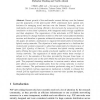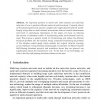MMNS
2004
14 years 25 days ago
2004
Most adaptive delivery mechanisms for streaming multimedia content do not explicitly consider user-perceived quality when making adaptation decisions. We show that an optimal adap...
MMNS
2004
14 years 25 days ago
2004
We present a generic Service Level Agreement (SLA)-driven service provisioning architecture, which enables dynamic and flexible bandwidth reservation schemes on a per-user or a per...
MMNS
2004
14 years 25 days ago
2004
As host mobility and radio interference in wireless networks cause packet losses and delays, it is difficult to develop useful mobile real-time media applications. This paper descr...
MMNS
2004
14 years 25 days ago
2004
Integrating multiple functions into one communication user agent can introduce many innovative communication services. For example, with networked appliance control, a user agent c...
MMNS
2007
14 years 26 days ago
2007
In this paper, we show the feasibility of real-time flow monitoring with controllable accuracy in today’s IP networks. Our approach is based on Netflow and A-GAP. A-GAP is a prot...
MMNS
2007
14 years 26 days ago
2007
Internet videoconferencing has emerged as a viable medium for communication and entertainment. However, its widespread use is being challenged. This is because videoconference end-...
MMNS
2007
14 years 26 days ago
2007
Recent growth of the multimedia content delivery over the Internet and the popularity of the peer-to-peer (P2P) architecture have opened new horizons for emerging novel services ov...
MMNS
2007
14 years 26 days ago
2007
We propose an admission control approach for IPTV in which decisions to admit new flows are based on effective bandwidth estimates calculated using empirical traffic measurement. W...
MMNS
2007
14 years 26 days ago
2007
As mobile devices and functionalities have increased and become intelligent, many related problems have occurred. Especially, the degraded quality of service caused by the shadow a...
MMNS
2007
14 years 26 days ago
2007
An important question in multi-radio multi-channel and multi-hop networks is how to perform efficient network-wide broadcast. Currently almost all broadcasting protocols assume a s...






